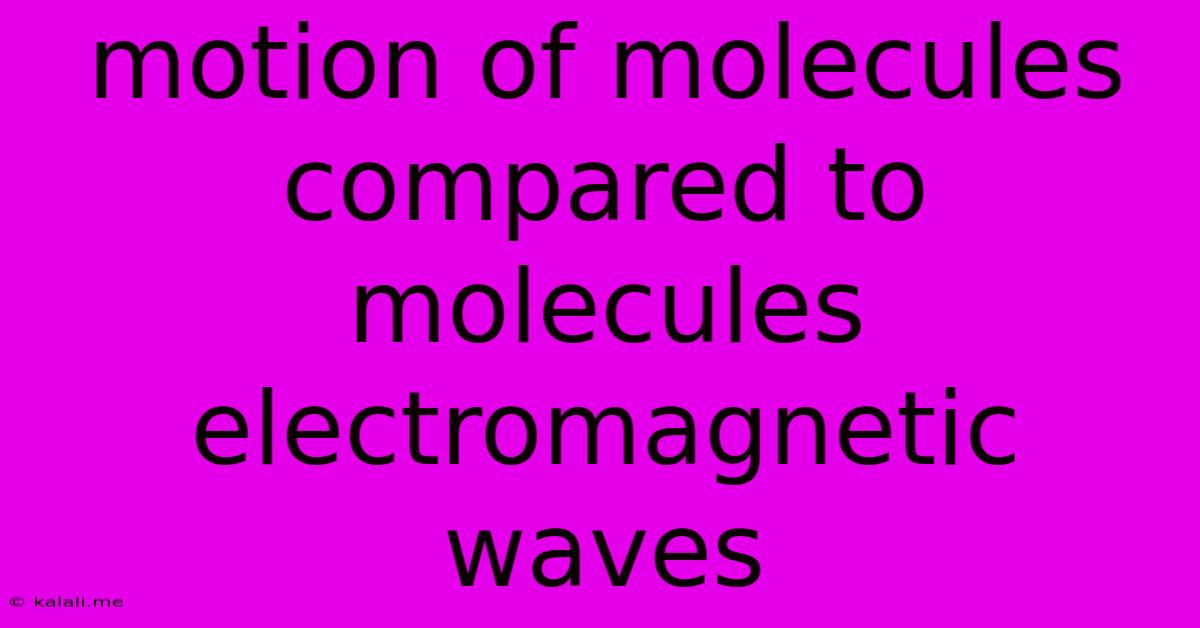Motion Of Molecules Compared To Molecules Electromagnetic Waves
Kalali
May 24, 2025 · 3 min read

Table of Contents
The Dance of Molecules: Comparing Molecular Motion and Electromagnetic Waves
This article delves into the fascinating differences and subtle connections between the motion of molecules and electromagnetic waves. While seemingly disparate, understanding their interactions is crucial in various fields, from chemistry and physics to materials science and even biology. This exploration will clarify the distinct characteristics of each, highlighting key concepts like kinetic energy, wavelength, and frequency.
Molecules, the fundamental building blocks of matter, are in constant motion. This motion, governed by the principles of thermodynamics and quantum mechanics, dictates many of the macroscopic properties we observe. From the fluidity of liquids to the rigidity of solids, the behavior of matter is a direct consequence of the ceaseless jiggling and vibrating of its constituent molecules.
Molecular Motion: A Microscopic Ballet
The type and extent of molecular motion depend on the state of matter. In solids, molecules vibrate around fixed positions, their movement restricted by strong intermolecular forces. Liquids exhibit more freedom, with molecules able to translate and rotate, leading to their characteristic fluidity. Gases, on the other hand, showcase the most unrestrained motion, with molecules moving independently at high speeds, frequently colliding with each other and the container walls.
Types of Molecular Motion:
- Translational motion: Molecules move from one location to another. This is most prominent in gases.
- Rotational motion: Molecules rotate about their center of mass. This is significant in liquids and gases.
- Vibrational motion: Atoms within a molecule oscillate around their equilibrium positions. This is present in all states of matter.
The kinetic energy of molecules is directly related to their temperature. Higher temperatures mean greater kinetic energy and thus more vigorous molecular motion. This explains why substances expand when heated – the increased molecular motion requires more space.
Electromagnetic Waves: A Symphony of Energy
Electromagnetic waves, unlike molecular motion, are not associated with the movement of matter itself. Instead, they represent the propagation of energy through space via oscillating electric and magnetic fields. These waves, encompassing everything from radio waves to gamma rays, travel at the speed of light and are characterized by their wavelength and frequency.
Key Characteristics of Electromagnetic Waves:
- Wavelength (λ): The distance between successive crests or troughs of the wave.
- Frequency (ν): The number of wave cycles passing a given point per unit time.
- Speed (c): The speed of light, a constant value in a vacuum. The relationship between these is given by c = λν.
Electromagnetic waves carry energy, which can be absorbed or emitted by molecules. This interaction is fundamental to various processes, including spectroscopy, where the absorption or emission of electromagnetic radiation provides information about the molecular structure and energy levels.
The Interplay: Where Molecules and Waves Meet
While distinct, molecular motion and electromagnetic waves are intimately connected. The absorption or emission of electromagnetic radiation by molecules can directly influence their kinetic energy and therefore their motion. For example, molecules in a gas can absorb infrared radiation, causing their vibrational energy to increase and leading to an increase in temperature and consequently, faster molecular motion.
Conversely, the motion of molecules can influence the emission of electromagnetic waves. For instance, the thermal motion of molecules in a heated object leads to the emission of infrared radiation – this is the basis of thermal imaging.
Understanding the intricate dance between molecular motion and electromagnetic waves is vital for numerous scientific and technological advancements. From developing new materials with specific properties to improving medical imaging techniques, this interplay continues to be a subject of ongoing research and innovation. The microscopic world of molecules and the vast expanse of electromagnetic radiation are far more connected than it might initially seem.
Latest Posts
Latest Posts
-
How Long Does A Monopoly Game Last
May 25, 2025
-
How To Remove Concrete Splatter From Concrete
May 25, 2025
-
Sub Panel Neutral And Ground On Same Bus Bar
May 25, 2025
-
Car Temperature Gauge Drops To Cold While Driving
May 25, 2025
-
Where Does Moses Write About Jesus
May 25, 2025
Related Post
Thank you for visiting our website which covers about Motion Of Molecules Compared To Molecules Electromagnetic Waves . We hope the information provided has been useful to you. Feel free to contact us if you have any questions or need further assistance. See you next time and don't miss to bookmark.